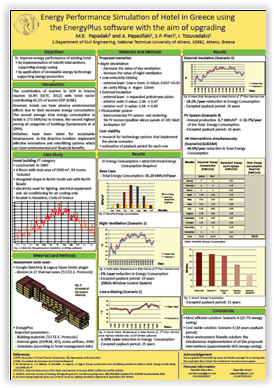 In the direction of "green entrepreneurship”, hotel units have to improve their operational infrastructures and business processes by adopting bioclimatic design solutions. The purpose of this study is the energy assessment of an existing hotel located in Heraklion of Crete with the aim of reducing its electric consumption. The hotel is classified into 3* category, it consists of 4 floors with total area of 4088 m2 and, according to the audit, the hotel’s monthly electricity consumption for the year 2013 was 160,880.00 kWh (39.4 KWh/m2). The assessment tools used in the study are google SketchUp (version 8.0), Legacy Open Studio plugin for SketchUp and the building energy simulation program Energy Plus (version 8.1). At an early stage of simulation, the building is designed in SketchUp and consequently all necessary parameters are imported in Energy Plus in order to estimate its total electricity consumptions. The parameters include building materials, human activity in the building and the total electricity consumption of the hotel. Total electricity consumption is calculated as the sum of the consumption of the lighting, air-conditioning and electrical equipment used by the hotel. The final sum of electric consumption that comes out is 141,515.00 kWh/year (34.6 kWh/m2/year), which means the results are 87% close to reality. The study proposes different retrofit interventions, each one of which is simulated through the program Energy Plus and evaluates their impact on energy consumption. Initially three different technology scenarios are proposed: the application of nocturnal ventilation, which results in a reduction in electricity by 4.6% /year, the replacement of existing glazing units by low-e (Low-emissivity) glazing, which results in a decrease of 3.36% /year and the placing of a layer consisting of expanded polystyrene plates as an external insulation in the shell of the building giving a decrease of 18.2% /year. The renewable energy (RE) scenario conserves energy, directly, by using an innovative interconnected PV system (net metering) consisting of 94 PV monocrystalline silicon panels of 245 Watt each, placed in a part of the hotel roof resulting in energy saving of 23.7% /year. Finally, the study examines the simultaneous application of all the four above interventions through Energy Plus simulation and results in a total decrease in electricity consumption of 49.9% /year. To conclude, the PV system intervention is the most efficient, individually, however the combination of the four above technologies is the most cost effective plan for the enterprise.
In the direction of "green entrepreneurship”, hotel units have to improve their operational infrastructures and business processes by adopting bioclimatic design solutions. The purpose of this study is the energy assessment of an existing hotel located in Heraklion of Crete with the aim of reducing its electric consumption. The hotel is classified into 3* category, it consists of 4 floors with total area of 4088 m2 and, according to the audit, the hotel’s monthly electricity consumption for the year 2013 was 160,880.00 kWh (39.4 KWh/m2). The assessment tools used in the study are google SketchUp (version 8.0), Legacy Open Studio plugin for SketchUp and the building energy simulation program Energy Plus (version 8.1). At an early stage of simulation, the building is designed in SketchUp and consequently all necessary parameters are imported in Energy Plus in order to estimate its total electricity consumptions. The parameters include building materials, human activity in the building and the total electricity consumption of the hotel. Total electricity consumption is calculated as the sum of the consumption of the lighting, air-conditioning and electrical equipment used by the hotel. The final sum of electric consumption that comes out is 141,515.00 kWh/year (34.6 kWh/m2/year), which means the results are 87% close to reality. The study proposes different retrofit interventions, each one of which is simulated through the program Energy Plus and evaluates their impact on energy consumption. Initially three different technology scenarios are proposed: the application of nocturnal ventilation, which results in a reduction in electricity by 4.6% /year, the replacement of existing glazing units by low-e (Low-emissivity) glazing, which results in a decrease of 3.36% /year and the placing of a layer consisting of expanded polystyrene plates as an external insulation in the shell of the building giving a decrease of 18.2% /year. The renewable energy (RE) scenario conserves energy, directly, by using an innovative interconnected PV system (net metering) consisting of 94 PV monocrystalline silicon panels of 245 Watt each, placed in a part of the hotel roof resulting in energy saving of 23.7% /year. Finally, the study examines the simultaneous application of all the four above interventions through Energy Plus simulation and results in a total decrease in electricity consumption of 49.9% /year. To conclude, the PV system intervention is the most efficient, individually, however the combination of the four above technologies is the most cost effective plan for the enterprise.

